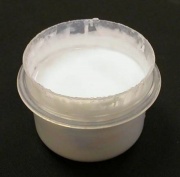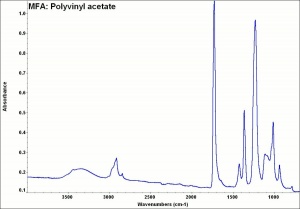Polyvinyl acetate
Description
A colorless, nontoxic thermoplastic resin prepared by the polymerization of vinyl acetate. Polyvinyl acetate (PVAC) was discovered in 1912 by Dr. Fritz Klatte in Germany. It is one of the most widely used water-dispersed resins. Polyvinyl acetate water-based emulsions have been used as latex house paints, artists' media (since 1945), and common household white glues. Setting is accomplished by the removal of water due to evaporation or absorption into a substrate. PVAC resins produce clear, hard films that have good weather resistance and withstand water, grease, oil, and petroleum fuels. Additional properties are high initial tack, almost invisible bond line, softening at 30-45C, good biodegradation resistance, poor resistance to creep under load, and low cost. Polyvinyl acetate resins and copolymers are also used as hot-melt adhesives, sealants, fabric finishing, plastic wood, and inks.
Synonyms and Related Terms
PVAC; PVAc; PVA (incorrect but commonly used); poly(vinyl acetate); polyvinylacetate; poli(acetato de vinilo) (Esp.); acétate de polyvinyle (Fr.); polivinil acetato (It.); poliacetato de vinilo (Port.); vinyl emulsion; vinyl acetate plastic
Examples: Vinamul [Vinyl Products]; AYAT [Union Carbide]; Elmers® Glue-All [Borden]; Duratite White Glue [DAP]; Gelva® [Solutia]; Rivit Glue; Resin W; Polymer Tempera [Borden]; Vinavyl; Everflex BG [W.R.Grace & Co.]; Polyco [DAP]; Vinnapas [Wacker]; Mowilith [Hoechst]; polyvinylacetat (Deut.)
Other Properties
Soluble in benzene, chloroform, methanol, acetone, butyl acetate.
Insoluble in ligroin, diethyl ether, butanol, turpentine, water, oils.
Can absorb 3-5% water when immersed for 16 hours at 60 C.
Burns with a dark yellow flame that smells of acetic acid.
| Composition | [-CH2CH(OOCCH3)-]n |
|---|---|
| CAS | 9003-20-7 |
| Melting Point | Tg = 30-45 |
| Density | 1.17-1.20 |
| Refractive Index | 1.46-1.47 |
Hazards and Safety
Combustible. pH of emulsions is usually acidic. PVAC resins release small amounts of acetic acid on curing and aging.
Fisher Scientific: MSDS
Additional Information
A.E.Corey, P.M.Draghetti, J.Fantl, "Polyvinyl Acetate Emulsions and Polyvinyl Alcohol for Adhesives" in Handbook of Adhesives, I.Skeist (ed.), Van Nostrand Reinhold, New York, 1977, p.465-483.
Comparisons
General Characteristics of Polymers
Physical Properties for Selected Thermoplastic Resins
Authority
- R. J. Gettens, G.L. Stout, Painting Materials, A Short Encyclopaedia, Dover Publications, New York, 1966
- G.S.Brady, Materials Handbook, McGraw-Hill Book Co., New York, 1971 Comment: p. 849
- Wikipedia, the free encyclopedia, at http://www.wikipedia.com Comment: http://en.wikipedia.org/wiki/Polyvinyl_acetate (Accessed Jan.6 2006)
- Richard S. Lewis, Hawley's Condensed Chemical Dictionary, Van Nostrand Reinhold, New York, 10th ed., 1993
- Matt Roberts, Don Etherington, Bookbinding and the Conservation of Books: a Dictionary of Descriptive Terminology, U.S. Government Printing Office, Washington DC, 1982
- Reed Kay, The Painter's Guide To Studio Methods and Materials, Prentice-Hall, Inc., Englewood Cliffs, NJ, 1983
- Pam Hatchfield, Pollutants in the Museum Environment, Archetype Press, London, 2002
- The American Heritage Dictionary or Encarta, via Microsoft Bookshelf 98, Microsoft Corp., 1998
- Jo Crook, Tom Learner, Modern Paints, Watson-Guptill Publications, New York, 2000
- Jo Crook, Tom Learner, Modern Paints, Watson-Guptill Publications, New York, 2000 Comment: First paint marketed in 1945 - Polymer Tempera by Borden
- Book and Paper Group, Paper Conservation Catalog, AIC, 1984, 1989
- Theodore J. Reinhart, 'Glossary of Terms', Engineered Plastics, ASM International, 1988
- Art and Architecture Thesaurus Online, http://www.getty.edu/research/tools/vocabulary/aat/, J. Paul Getty Trust, Los Angeles, 2000
- Website address 1 Comment: www.nswpmith.com.au/historyofplastics.html .. vinyl acetate was discovered in Germany by Dr. Fritz Klatte in 1912 with patents for its preparation


